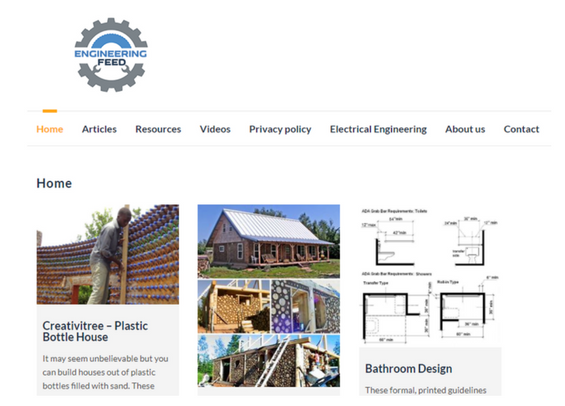- Fastbricks Robotics is leading the way when it comes to robotic construction. They’re a robotic technology company developing and commercialising digital construction technology solutions, including the revolutionary commercial bricklaying machine, Hadrian X, showcased in the animation. It’s the first part of a digital construction system which they believe will change the world, making housing affordable for everyone.
Archives for Our Industry
World’s largest dams
What is a dam?
Dams are built to control and store water. Dams are made from earth, stacked rock or concrete, and are usually constructed across rivers to store water in the reservoir that is formed behind the dam as a result of the river being blocked.
How do dams work?
Dams store water in the reservoir formed behind the dam. The stored water can be used for various consumptive purposes, including use as water for irrigation, or as sources of drinking water for urban and regional towns and cities. The stored water can also be discharged from the reservoir during the times that natural flows in downstream rivers are inadequate to help meet a variety of environmental objectives.
Depending on the catchment area for the dam, the water stored in dam reservoirs is usually easier to treat to a drinking water standard than other sources of drinking water, such as run of river supplies. This is because the long time spent in storage usually improves the quality of the water stored in the reservoir.
Definition of a large dam
The International Commission on Large Dams defines a large dam as one which is:
- More than 15 metres in height measured from the lowest point of the general foundations to the crest of the dam,
- More than 10 metres in height measured as in (a) provided they comply with at least one of the following conditions:
- The crest is not less than 500 metres in length
- The capacity of the reservoir formed by the dam is not less than 1 million cubic metres
- The maximum flood discharge dealt with by the dam is not less than 2000 cubic metres per second
- The dam is of unusual design
Here are 5 of the world’s largest dams:
Hirakud Dam is built across the Mahanadi River, about 15 kilometres (9.3 mi) from Sambalpur in the state of Odisha in India. Behind the dam extends a lake, Hirakud Reservoir, 55 km (34 mi) long. It is one of the first major multipurpose river valley projects started after India’s independence. The Hirakud Dam is a composite structure of earth, concrete and masonry. 10 km (6.2 mi) north of Sambalpur, it is the longest major earthen dam in India, measuring 25.8 km (16.0 mi) including dykes, and stands across the river Mahanadi.
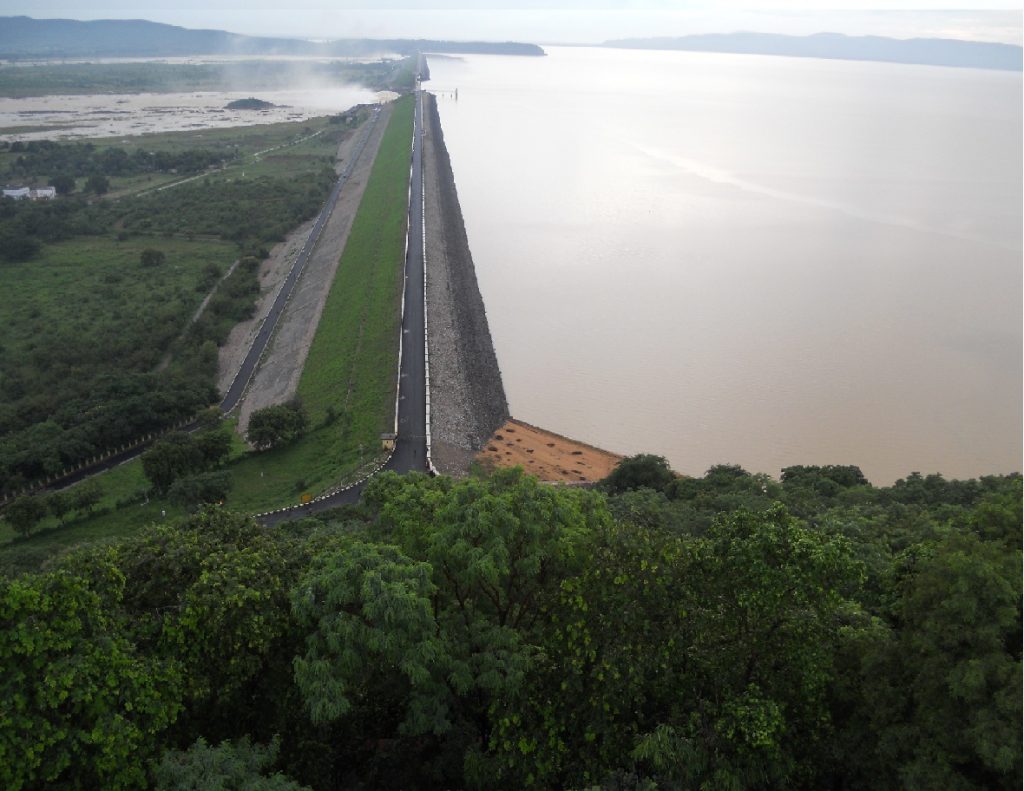
Vital Statistics
Country: India
Year completed: 1976
Length: 4.8 km (3 mi) (main section) 25.8 km (16 mi) (entire dam)
Height: 60.96 m (200 ft)
Type: Composite dam and reservoir
Total capacity: 5,896,000,000 m3 (4,779,965 acre·ft)
Fort Peck Dam Tis the highest of six major dams along the Missouri River, located in northeast Montana in the United States, near Glasgow, and adjacent to the community of Fort Peck. It is the largest hydraulically filled dam in the United States and creates Fort Peck Lake, the fifth largest man-made lake in the U.S.
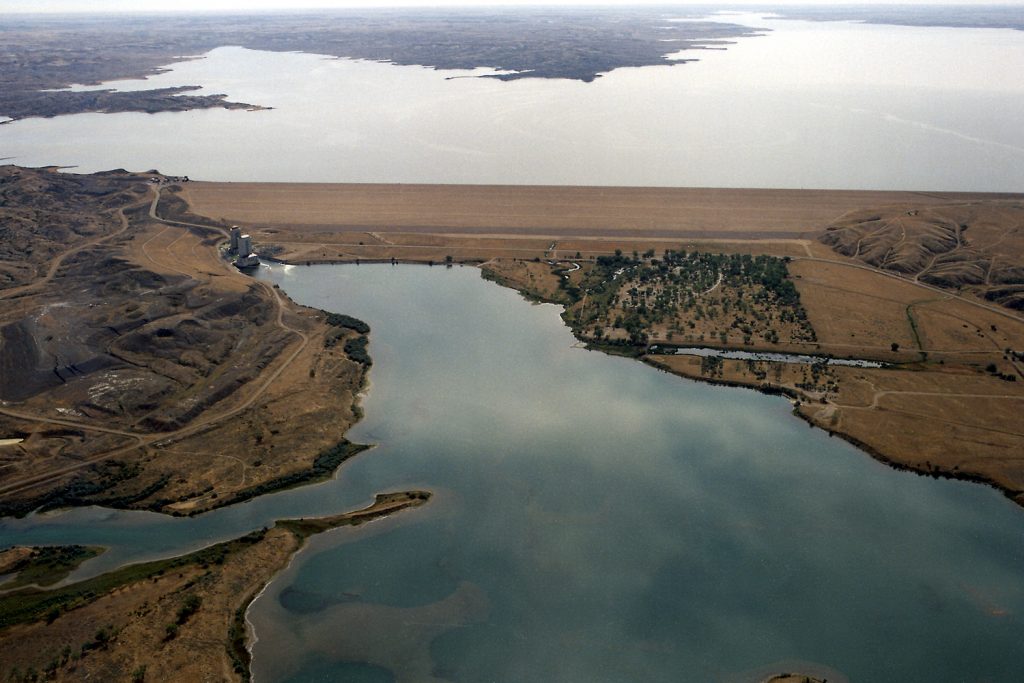
Vital Statistics
Country: United States
Year completed: 1940
Length: 21,026 ft (6,409 m)
Height: 250 ft (76 m)
Type: Hydraulic earthfill
Reservoir Capacity: 18,463,000 acre·ft (22.774 km3)
Atatürk Dam originally the Karababa Dam, is a zoned rock-fill dam with a central core[1] on the Euphrates River on the border of Adıyaman Province and Şanlıurfa Province in the Southeastern Anatolia Region of Turkey. Built both to generate electricity and to irrigate the plains in the region, it was renamed in honour of Mustafa Kemal Atatürk (1881–1938), the founder of the Turkish Republic.

Vital Statistics
Country: Turkey
Year completed: 1990
Length: 1,819 m (5,968 ft)
Height: 169 m (554 ft)
Type: Reservoir
Reservoir Capacity: 48,700,000,000 m3 (39,500,000 acre·ft)
Houtribdijk is a dike in the Netherlands, built between 1963 and 1975 as part of the Zuiderzee Works, which connects the cities of Lelystad and Enkhuizen. On the west side of the dike is the Markermeer and on the east is the IJsselmeer. Although called a dike, the Houtribdijk is actually a dam.
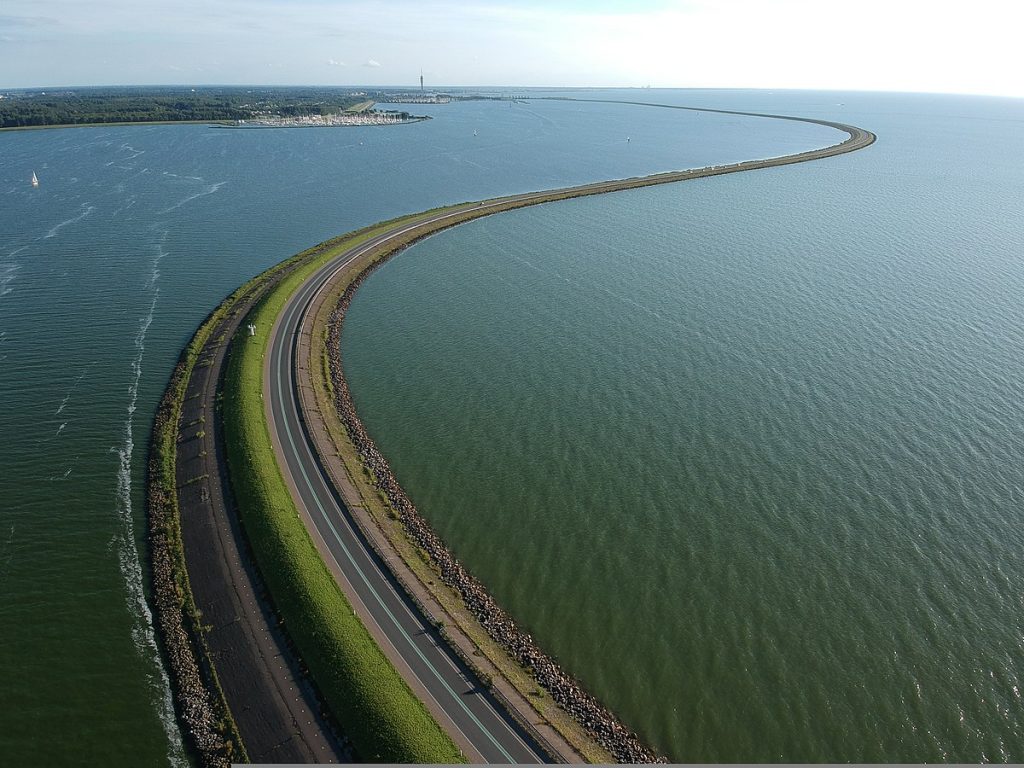
Vital Statistics
Country: Netherlands
Year completed: 1968
Length: 30 km
Height: 68 m
Oahe Dam is a large dam along the Missouri River, just north of Pierre, South Dakota in the United States. It creates Lake Oahe, the fourth largest artificial reservoir in the United States, which stretches 231 miles (372 km) up the course of the Missouri to Bismarck, North Dakota. The dam’s powerplant provides electricity for much of the north-central United States. It is named for the Oahe Indian Mission established among the Lakota Sioux in 1874.
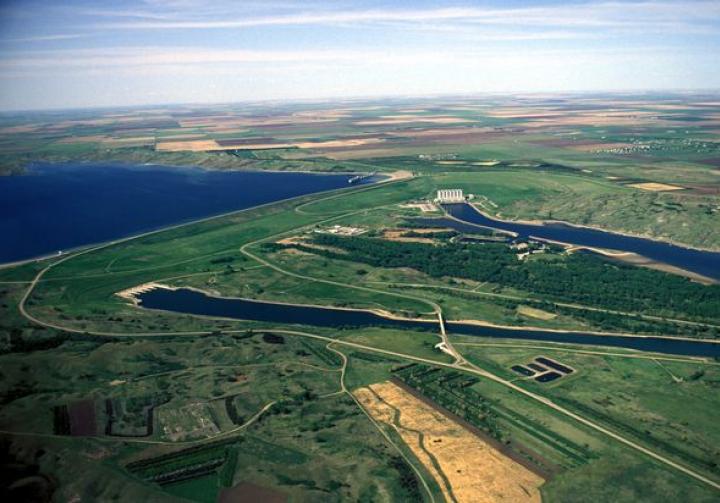
Vital Statistics
Country: United States
Year completed: 1963
Length: 9,360 feet (2,850 m)
Height: 245 feet (75 m)
Type: flood control, earthfill
Reservoir Capacity: 23,137,000 acre feet (28.539 km3)
10 oldest man-made earth structures
Most of these buildings are still standing today. A true testament to brilliant engineering. Check them out!
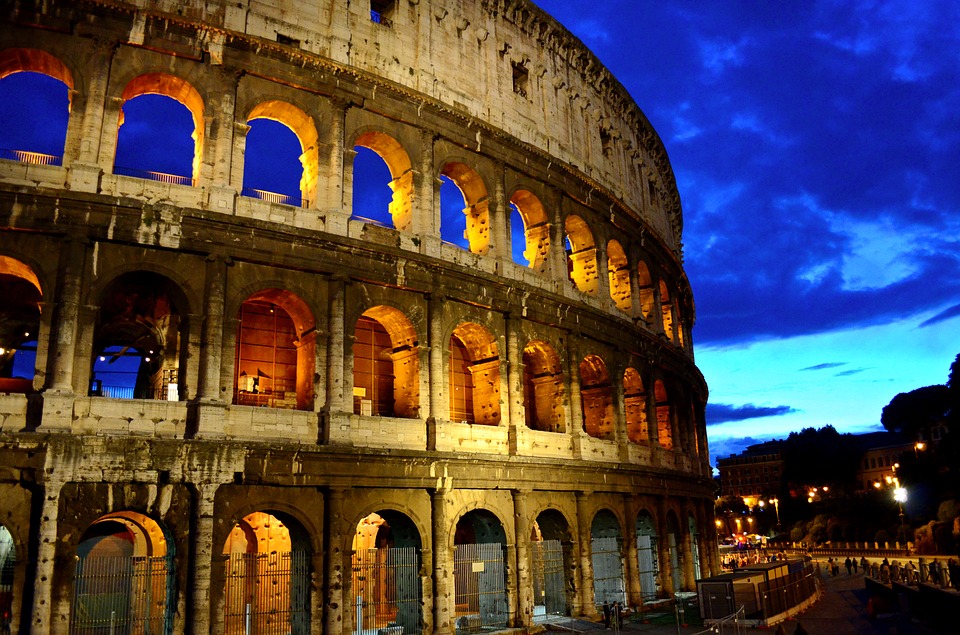
Located just east of the Roman Forum, the massive stone amphitheatre known as the Colosseum was commissioned around A.D. 70-72 by Emperor Vespasian of the Flavian dynasty as a gift to the Roman people. In A.D. 80, Vespasian’s son Titus opened the Colosseum–officially known as the Flavian Amphitheater–with 100 days of games, including gladiatorial combats and wild animal fights. After four centuries of active use, the magnificent arena fell into neglect, and up until the 18th century, it was used as a source of building materials. Though two-thirds of the original Colosseum has been destroyed over time, the amphitheatre remains a popular tourist destination, as well as an iconic symbol of Rome and its long, tumultuous history.

Stonehenge is perhaps the world’s most famous prehistoric monument. It was built in several stages: the first monument was an early henge monument, built about 5,000 years ago, and the unique stone circle was erected in the late Neolithic period about 2500 BC. In the early Bronze Age, many burial mounds were built nearby. Today, along with Avebury, it forms the heart of a World Heritage Site, with a unique concentration of prehistoric monuments.
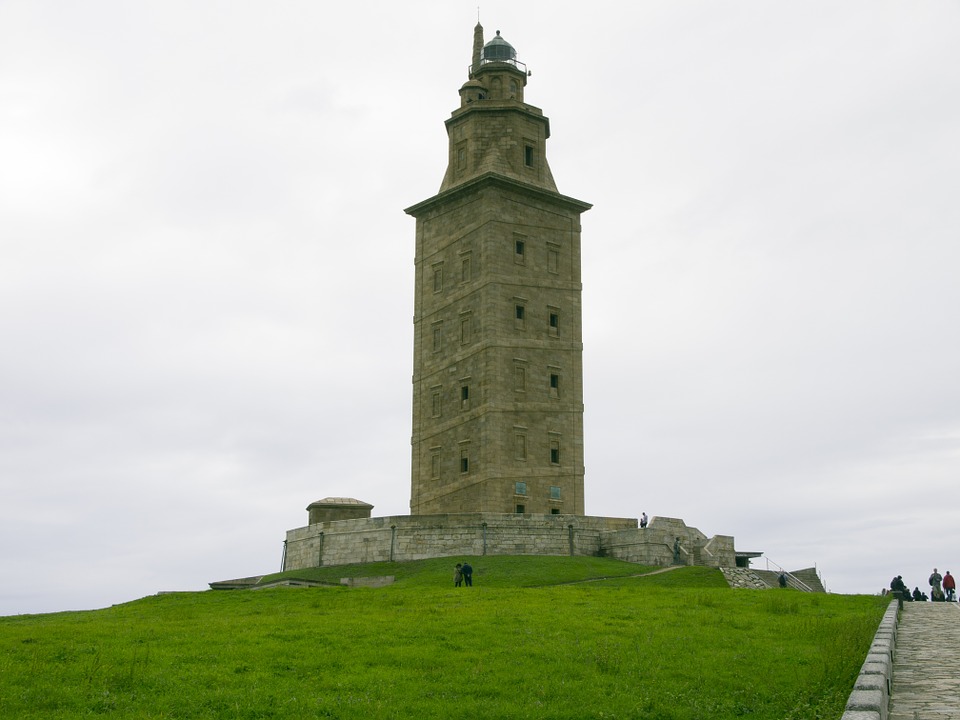
The Tower of Hercules has served as a lighthouse and landmark at the entrance of La Coruña harbour in north-western Spain since the late 1st century A.D. when the Romans built the Farum Brigantium. The Tower, built on a 57-metre high rock, rises a further 55 metres, of which 34 metres correspond to the Roman masonry and 21 meters to the restoration directed by architect Eustaquio Giannini in the 18th century, who augmented the Roman core with two octagonal forms. Immediately adjacent to the base of the Tower is a small rectangular Roman building. The site also features a sculpture park, the Monte dos Bicos rock carvings from the Iron Age and a Muslim cemetery. The Roman foundations of the building were revealed in excavations conducted in the 1990s. Many legends from the Middle Ages to the 19th century surround the Tower of Hercules, which is unique as it is the only lighthouse of Greco-Roman antiquity to have retained a measure of structural integrity and functional continuity.
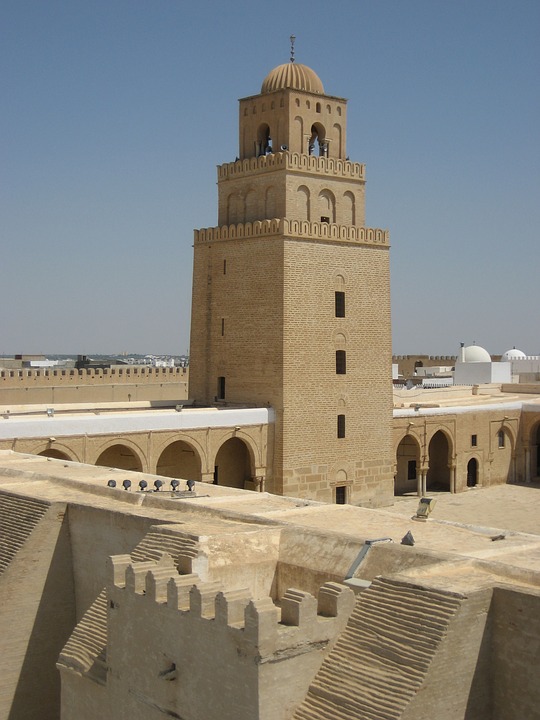
The Mosque of Uqba also known as the Great Mosque of Kairouan is located in the historic walled district of the Medina, between the Rue de la Kasbah and the Rue el Farabi in Tunisia. The mosque, as it stands today, was built by the Aghlabid governor of Kairouan, Ziyadat Allah, between 817 and 838. He erected the building on the site of an older mosque, originally constructed by Uqba ibn Nafi at the time of the 670 AD Arab conquest of Byzantine North Africa. Although the current mosque retains virtually no trace of the original seventh-century building, it is still often referred to as “Mosque of Sidi Uqba,” or,”Mosque of Uqba Ibn Nafi.” Historically, it has been accorded great significance as the first mosque in the first town of Islam in the West.

Acoma Pueblo is built atop a sheer-walled, 367-foot sandstone bluff in a valley studded with sacred, towering monoliths. Since 1150 A.D., Acoma Pueblo has earned the reputation as the oldest continuously inhabited community in North America. The mesa-top settlement is known worldwide for its unique art and rich culture.
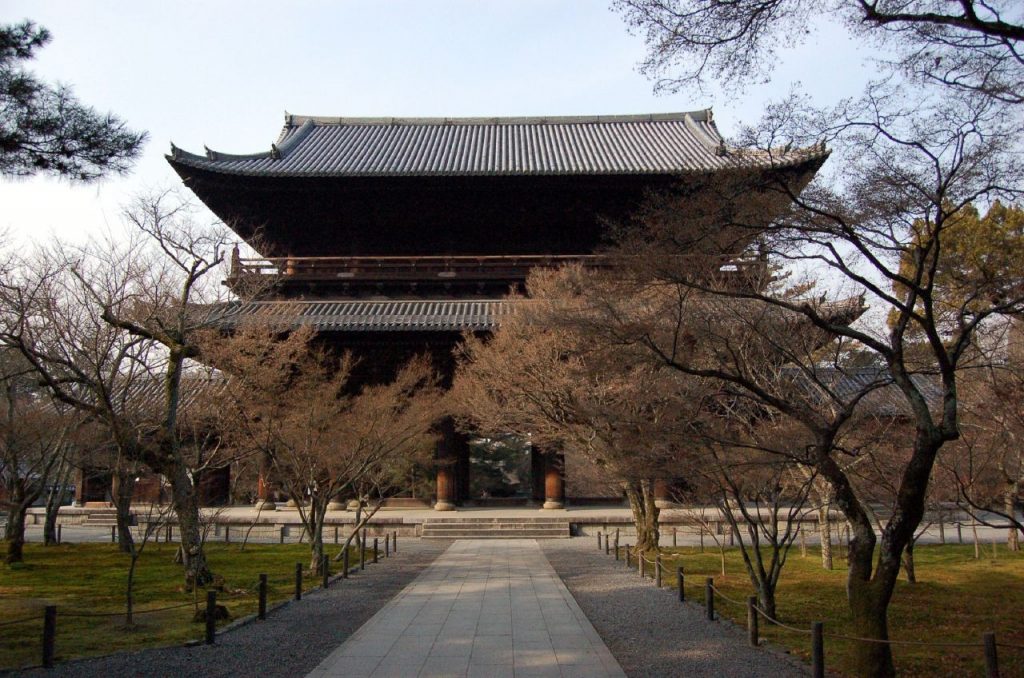
The Nanchan Temple is a Buddhist temple near the town of Doucun on Wutaishan, in Shanxi Province, China. It was built in 782 AD, and its Great Buddha Hall is currently China’s oldest preserved timber building in existence
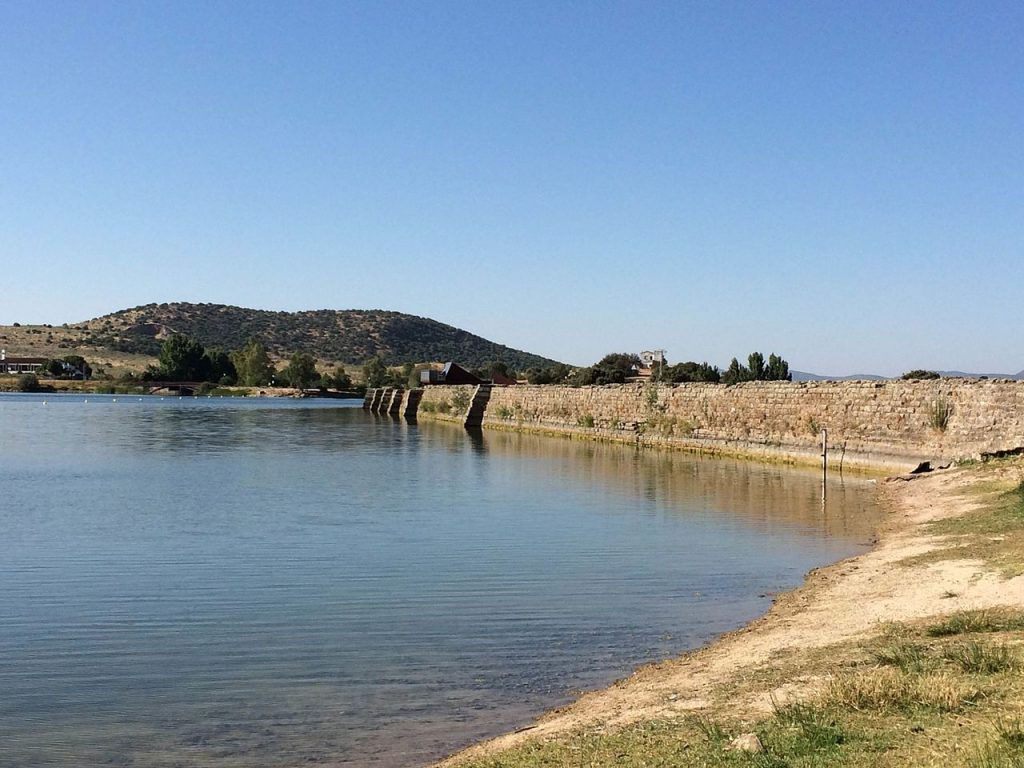
The Proserpina Dam, located approximately ten kilometres north of Merida in Spain, is the world’s second oldest dam currently in use. The earthen dam was constructed by the Romans between the late 1st century AD and early 2nd century AD. It is covered with concrete and measures 427m long and 22m high. It is located on the course of the brook of Las Pardillas, a sub-tributary of the Guadiana on its right bank. It has two bends in the crest and nine buttresses on the inner side. The Confederación Hidrográfica del Guadiana (Water Management Administration) refurbished the dam in 1991.
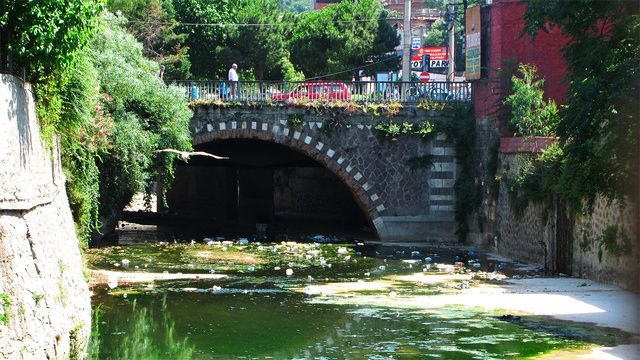
Built in 850 B.C., the Caravan Bridge is 2,861 years old and has reportedly been crossed by the likes of Homer and Saint Paul. The arched stone slab straddling the River Meles, in Izmir, Turkey, extends only 42 and a half feet and is about as simple as they come.

Ponte Fabricio was built in 62 b.C. by L.Fabricius curator viarum (as it is inscribed on both sides of the bridge). This is the oldest Roman bridge to have survived in the city, and still in use for pedestrians.
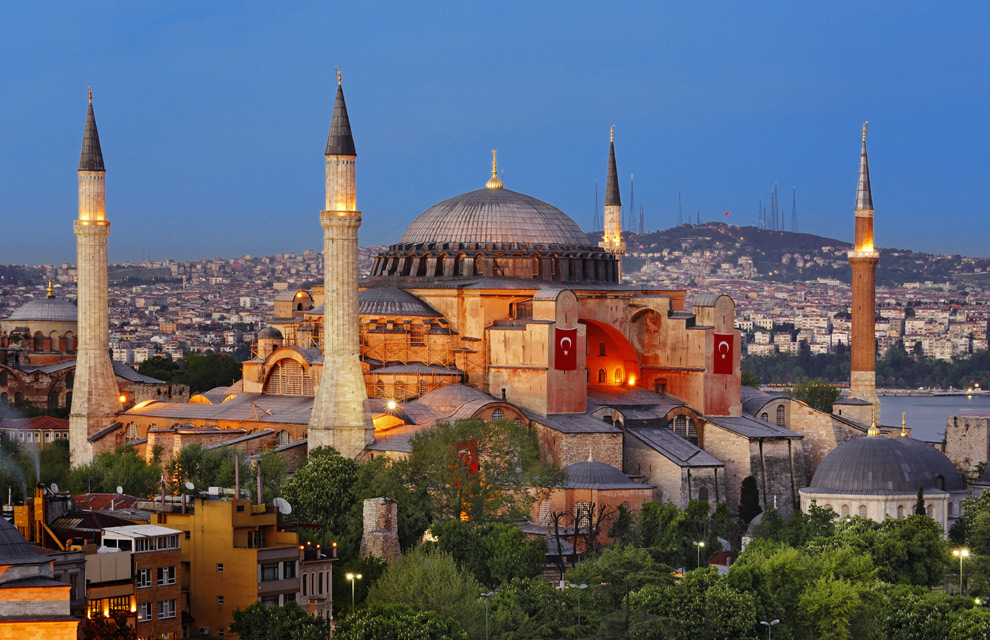
The Santa Sophia (also known as Hagia Sophia) in Istanbul, Turkey has been a church, mosque and museum since it was completed in 537 AD. It is a great architectural beauty and an important monument both for Byzantine and for Ottoman Empires.
Future tallest 10 skyscrapers
Let’s take a peek into the future and check out the world’s future tallest 10 skyscrapers!
1. Jeddah Tower – Destined to hold the title of the world’s tallest structure, the Kingdom Tower is envisioned to become the leading beacon of business, leisure and open the door to a futuristic metropolis. Reaching towards unprecedented heights, this landmark is the shining point intended to place Jeddah in the global arena, setting new levels of business, accommodation, and community lifestyle. Located in the Northern part of Obhur, Saudi Arabia The Jeddah Tower stands tall amidst the majestic Jeddah Economic City, amassing a complete set of amenities ranging from Business facilities, offices, a grand hotel, commercial shops, residential spaces, parks and much more, with a vast shopping area. While the Jeddah Economic City is envisioned to overlook the Pearl of the Red Sea, the Jeddah Tower’s mega height is intended to overlook much more than the eye can see, at a height of over a kilometre, and sporting the world’s highest observation deck.
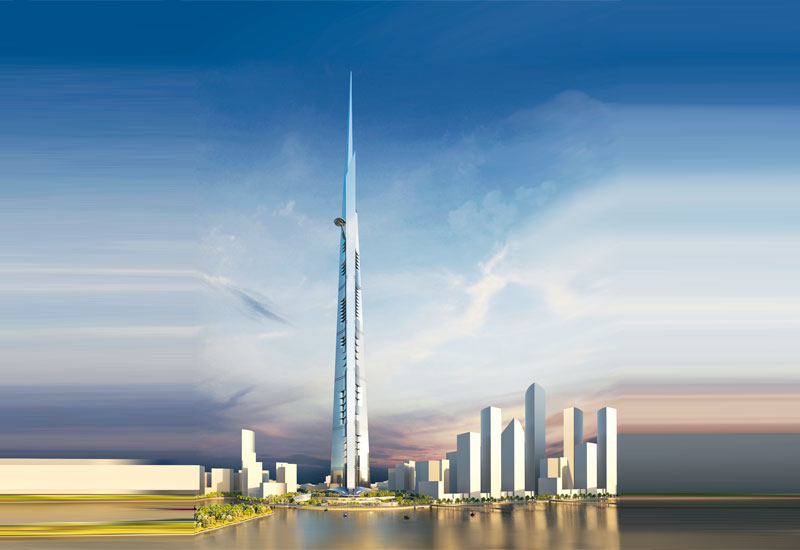
Vital Statistics
- Height: To Tip 1000+ m / 3,281+ ft
- Height: Architectural 1000+ m / 3,281+ ft
- Height: Observatory 644 m / 2,113 ft
- Floors Above Ground 167
- Floors Below Ground 2
- # of Elevators 59
- # of Apartments 439
- # of Hotel Rooms 200
- # of Parking Spaces 2,205
Timeline
- Proposed 2011
- Construction Start 2013
- Completion 2020
2. Wuhan Greenland Center – Rising from its site on the Yangtze River waterfront, the Wuhan Greenland Center symbolizes the growing vitality of Wuhan, the most populous city in central China and a major player in the country’s economy due to its status as a multi-modal transportation hub.
Like many towers that seek to transcend the 600-meter threshold, wind and seismic considerations were paramount in the design process. To address these issues, the tower uses a triangular floor plan that gently narrows along its height to provide extra stability that protects against intense winds and seismic events. Three large sloping steel-reinforced concrete (SRC) columns rise and join at the top of the building to form the 61-meter crown structure that rests above a glass dome. By omitting portions of floors and perimeter framing at different elevations, “slots” are created in the building envelope to provide a distinctive architectural personality while reducing wind loads on the structure. In this respect, the locations and geometry of structural components have been carefully optimized to not only provide strength and stiffness but integrate seamlessly with the form of the building.

Vital Statistics
- Height: Occupied 575 m / 1,886 ft
- Height: To Tip 636 m / 2,087 ft
- Height: Architectural 636 m / 2,087 ft
- Floors Above Ground 125
- Floors Below Ground 6
- # of Elevators 84
- # of Apartments 186
- # of Hotel Rooms 292
- # of Parking Spaces 1,051
Timeline
- Proposed 2010
- Construction Start 2012
- Completion 2018
3. Merdeka PNB118 – formerly known as KL118, Merdeka PNB118 is a 118-storey, 682-metre (2,238-foot) megatall skyscraper currently under construction in Kuala Lumpur, Malaysia. When completed, the tower will be the tallest building in Malaysia. The tower is sited at Petaling Hill, a low-density hill directly southeast of the historic Kuala Lumpur old town, on the location of the former Merdeka Park (which was subsequently repurposed into an open-air car park). The site lies within the vicinity of a number of historic landmarks with little modern development. The tower is to create a memorable new landmark for Kuala Lumpur.

Vital Statistics
- Height: Occupied 500 m / 1,640 ft
- Height: To Tip 630 m / 2,067 ft
- Height: Architectural 630 m / 2,067 ft
- Floors Above Ground 118
- Floors Below Ground 5
- # of Elevators 87
- # of Hotel Rooms 236
Timeline
- Proposed 2010
- Construction Start 2014
- Completion 2021
4. Rama IX Super Tower – is a skyscraper in Bangkok, Thailand currently under construction. When completed, it will be the tallest building in Thailand. The front podiums comprise of open-air multi-purpose plaza above modern conference facilities, and retail arcades which are also clustered in a low-rise building flanking The Super Tower. The tower which will also house Thailand’s first 24-hour office facilities, a six-star hotel, fine dining venues, and an enclosed observation deck. This extraordinary eco-friendly, energy-efficient skyscraper will be designed to LEED Platinum.
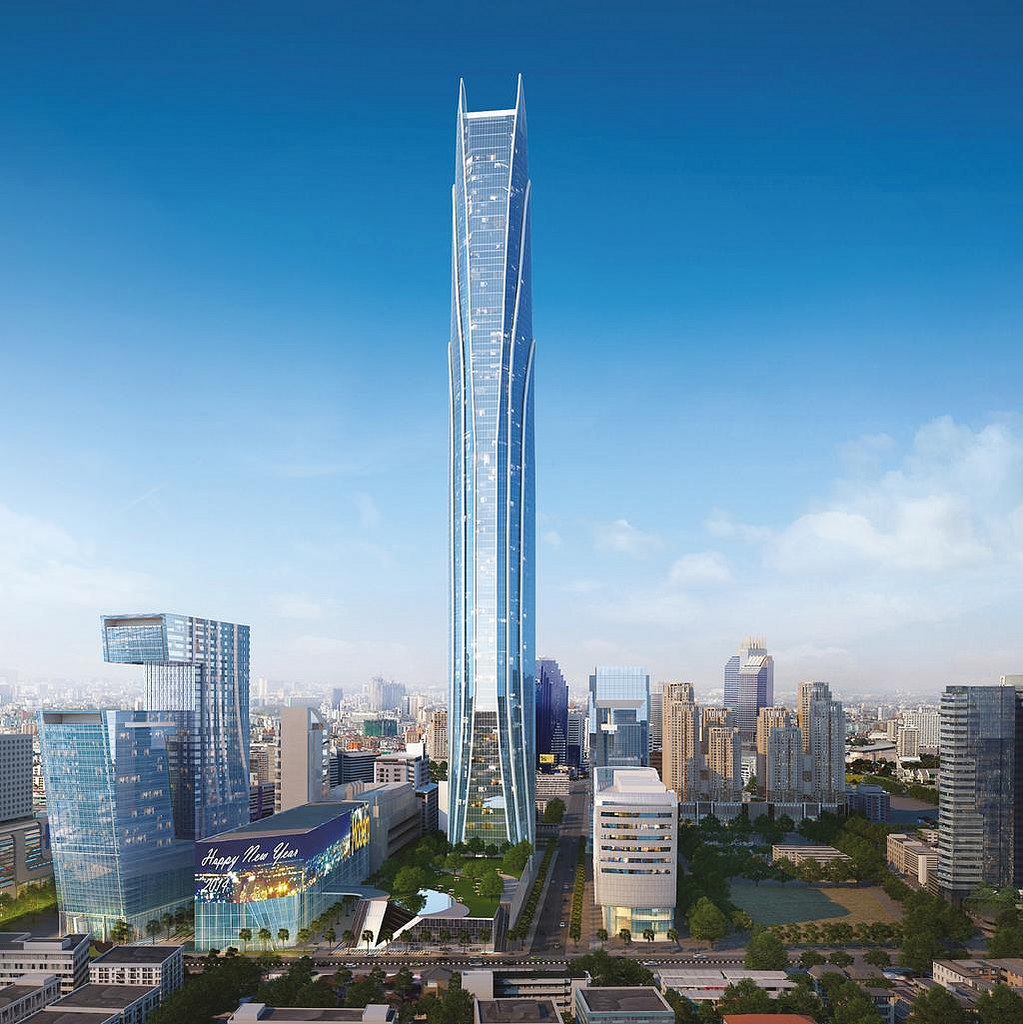
Vital Statistics
- Height: Architectural 615 m / 2,018 ft
- Height: To Tip 615 m / 2,018 ft
- Floors Above Ground 125
- Tower GFA 360,000 m² / 3,875,008 ft²
- # of Hotel Rooms 260
Timeline
- Proposed 2014
- Construction Start 2017
- Completion 2021
5. Global Financial Center Tower 1 – The design of Global Financial Center Tower 1 represents an exercise in both simplicity and iconicity. At the ground level, the tower meets the street at the human scale, with conical extrusions that downplay its verticality near the entrance. These canopies recall the nomadic tent entrances of the Qing Dynasty. Rising upward, the tower widens slightly before it tapers, giving it an oblong appearance. For structural consideration in a high seismic zone, the tower shaft evolves from a square to a convex plan with corners carved out to further reduce the considerable bulk of the tower and to soften the scale contrast with the surrounding residential towers. At the top, an executive club is located within a giant “pearl” that measures 50 meters in diameter. The pearl – a symbol of wisdom, luxury, and purity – is the jewel in the crown of this mixed-use development.
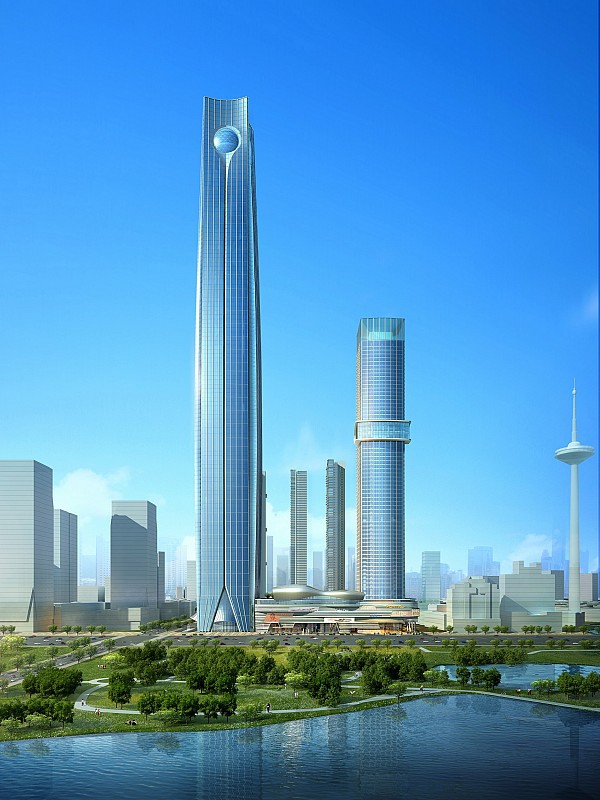
Vital Statistics
- Height: Occupied 518 m / 1,699 ft
- Height: To Tip 568 m / 1,864 ft
- Height: Architectural 568 m / 1,864 ft
- Floors Above Ground 114
- Floors Below Ground 5
Timeline
- Proposed 2013
- Construction Start 2014
- Completion 2019
6. Skyfame Center Landmark Tower – Also known as the Tianyu Tower, this skyscraper is being built in Nanning, China is due to be completed in 2021. It has 108 floors but as yet, the people behind the project have not released many details concerning its features.
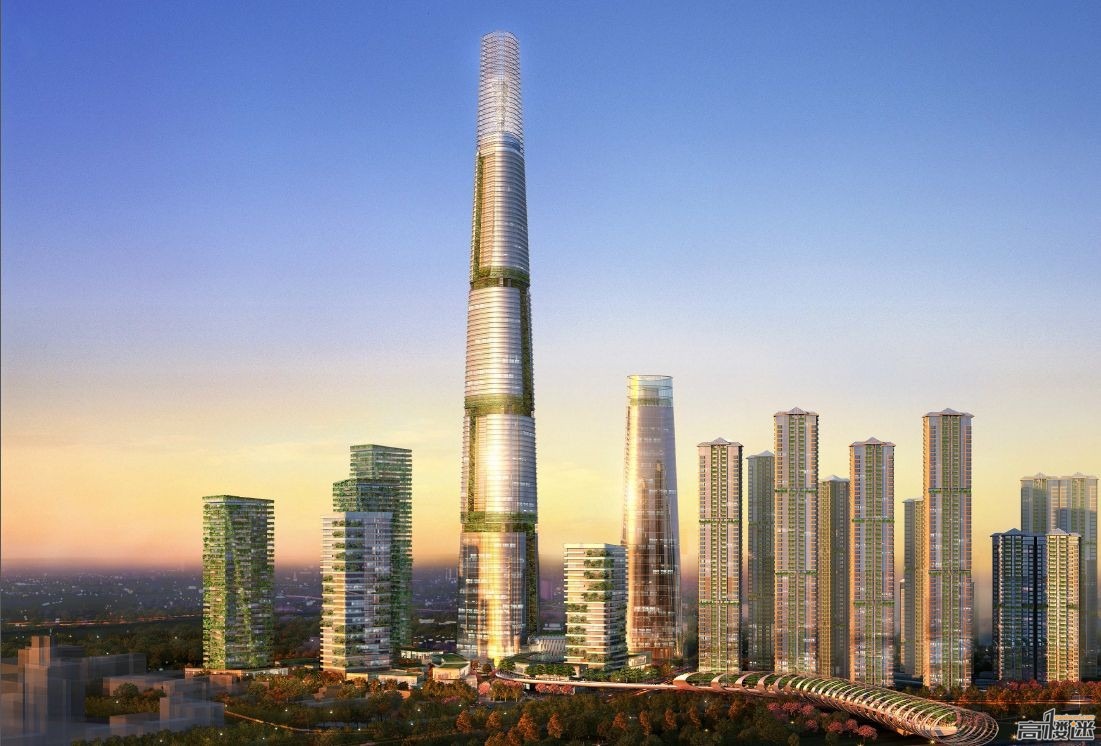
Vital Statistics
- Height: Architectural 528 m / 1,732 ft
- Height: To Tip 528 m / 1,732 ft
- Floors Above Ground 108
Timeline
- Proposed 2014
- Construction Start 2016
- Completion 2021
7. Evergrande International Financial Center – is a complex of five skyscrapers under construction at Chao Lake in Hefei, China. Work began in 2016. The highest towers will be 518 meters while the other four will peak at 290, 260, 200 and 170 meters respectively.
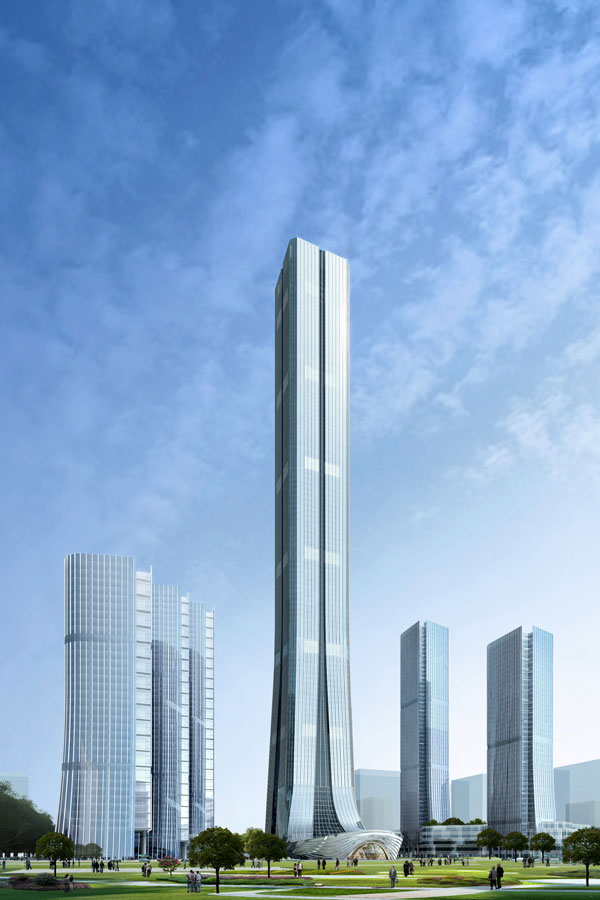
Vital Statistics
- Height: Architectural 518 m / 1,699 ft
- Height: To Tip 518 m / 1,699 ft
- Floors Above Ground 112
Timeline
- Proposed 2012
- Construction Start 2016
- Completion 2021
8. Central Park Tower – this tower is a supertall mixed-use commercial/residential project being developed by the Extell Development Company in Midtown Manhattan, New York City. Upon completion, Central Park Tower will become the second tallest skyscraper in the United States. The building will also be the tallest by roof height in the United States, surpassing the Willis Tower.

Vital Statistics
- Height: Occupied 442 m / 1,450 ft
- Height: To Tip 472.4 m / 1,550 ft
- Height: Architectural 472.4 m / 1,550 ft
- Floors Above Ground 95
- # of Apartments 179
Timeline
- Proposed 2010
- Construction Start 2014
- Completion 2020
9. Chengdu Greenland Tower – is a supertall skyscraper under construction in Chengdu, Sichuan, China. It will consist of: a retail podium, complete with conference centre, a bridge connecting to the main tower, and an exhibition hall; two smaller apartment towers of 173 and 166 meters; and the main tower, containing an array of office accommodations and a luxury hotel. The overall design of the complex interprets and integrates Chengdu’s urban structure and local culture, representing the modern embodiment of Chinese traditional feng shui theory.
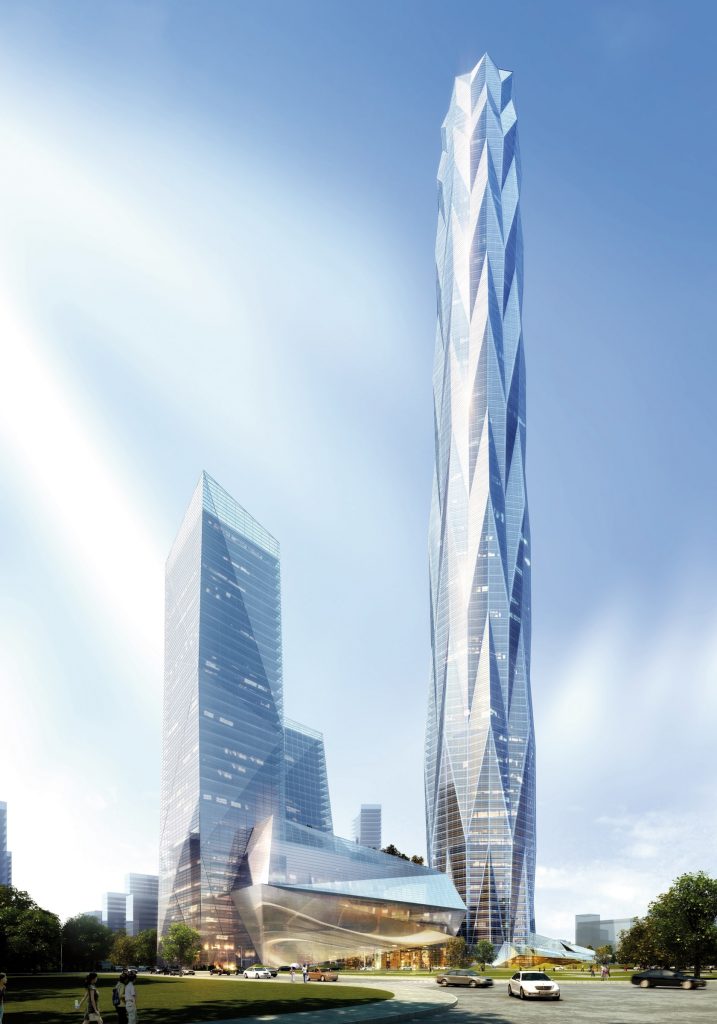
Vital Statistics
- Height: Occupied 448.2 m / 1,470 ft
- Height: To Tip 468 m / 1,535 ft
- Height: Architectural 468 m / 1,535 ft
- Floors Above Ground 101
- Floors Below Ground 4
- # of Parking Spaces 1,651
Timeline
- Proposed 2011
- Construction Start 2014
- Completion 2019
10. Corporate Avenue 1 – As a centrepiece of the 3.6-million-square-meter Chongqing Tian Di Master Plan, a major redevelopment of the downtown core area, the Chongqing International Commerce Center will provide a nexus of activity, bringing people together for both work and leisure. Informed by curvilinear geometry, the complex’s light and graceful form are clearly expressed in the simple configuration of the Corporate Avenue 1, the tallest tower on the site.
Vital Statistics
- Height: Occupied 429.6 m / 1,409 ft
- Height: To Tip 468 m / 1,535 ft
- Height: Architectural 468 m / 1,535 ft
- Floors Above Ground99
- Floors Below Ground4
- # of Elevators44
- # of Parking Spaces 815
Timeline
- Proposed 2007
- Construction Start 2012
- Completion 2019
An engineer has found a way to build roads with recycled plastic
Engineer Toby McCartney wants to use recycled plastic instead of oil to repair some of the world’s 40 million kilometers (24.8 million miles) of road. The idea would solve more than one problem: poor road quality, the continued use of fossil fuels, and the waste plastic epidemic. His Scottish start-up, MacRebur, mixes waste plastic into asphalt to create roads that last longer and are less prone to getting potholes.
Some of the waste plastics retrieved by the pickers were put into potholes, petrol poured all over them, and the rubbish set alight until the plastics melted into the craters to form a makeshift plastic pothole filler.
Upon returning to the U.K., Toby got together with his two mates, waste expert Nick and construction engineer Gordon, and formed MacRebur. They take waste plastic that is destined for landfill sites and recycle it. They use a special formula to clean it off, create pellets using it, and then use those pellets to add to a mixture of rocks and bitumen to make longer-lasting roads.
So far, the scheme has won the approval of Virgin founder Sir Richard Branson, and McCartney’s company MacRebur has gotten the support of two local governments in England to start using MR6, MacRebur’s patent pending, high performance, asphalt binder additive to build their roads.
We reckon we could use some plastic roads in Australia too!
Melbourne to Sydney in just 53 minutes?
Thanks to Hyperloop Technology, travelling from Melbourne to Sydney could be hopefully done in under one hour!
But what is Hyperloop?And how is it going to change our travelling lives for the better?
Hyperloop has significant advantages for travelers, the economy, and the environment. Eventually, it will be able to travel far faster than any method of land based transport currently available — with its closest competitor, the bullet train, only capable of speeds of 320 km/h (200 mph). Projections indicate that it will also be cheaper to build than bullet train systems.
VicHyper wants to revolutionise the future of transport in Australia. Their CEO, Zac McLelland who is based at RMIT, said the hyperloop technology which had the potential to leapfrog fast rail and link the cities with ease, existed. It was now just a matter of putting it into practice. “If we really wanted to do it, we could do it now, and be built within three to five years,’’ Mr McLelland said.

Game on!
Five websites every civil engineer should follow
The internet is a goldmine of information but sifting through what’s useful for you as a civil engineer can take up many precious hours so we’ve done the hard work for you and collated the top five websites that you should check out and subscribe to if you haven’t already.
Interesting Engineering – It’s a leading community with more than 7 million+ minds. Their aim is to share a new idea, a new thought, an upcoming technology or an engineering breakthrough that will change the way you think about technology and engineering in today’s world and in the near future. Whether it’s a device that can charge your mobile in seconds or it’s the latest model of Boeing that has launched moments ago, Interesting Engineering will bring everything up on your screen to view, share and grant you the power to comment. Check out their latest articles here.

Engineering Feed – This site is chock-full of educational resources gallery exclusively for young civil engineers. They even have an FAQs dedicated to civil engineers. Awesome right? Their mission is to provide an e-library of good quality educational materials as collected from various eminent sources to support the learning requisites of civil engineering students throughout the world, promoting the concept of green-learning and the value of sharing knowledge. They want to offer a virtual platform to exchange, discuss and connect the knowledge contents of the latest kind for civil engineers beyond any barriers.
I am Civil Engineer – We love the site’s tagline: “bridging the gap, filling the void.” Clever yes? Their team consists of two civil engineers and two civil engineering students, one of which is a female. The site offers free downloads of books, softwares, excel sheets, presentations and tutorials. In their latest article, they share the 300+ yes 300+ civil engineering interview questions you must prepare for!
Engineering.Com – They’re a digital media publisher that brings the most influential voices in engineering to a worldwide audience of designers and engineers. The stories that they produce highlight the latest advances in technology for product innovation and manufacturing. Their mission is to deliver engaging stories that inspire engineers to push the boundaries of innovation.
Engineers Australia – Of course we’ll include an Australian one! Engineers Australia is the trusted voice of the profession. They are the largest and most diverse body of engineers in Australia. As Australia’s principal engineering association they serve and represent over 100,000 professionals at every level, across all fields of practice. They are committed to advancing engineering and the professional development of their members.
The world’s future megaprojects
This is a fascinating documentary on eight of the most ambitious mega-projects currently under development around the world, featuring: Istanbul’s building boom (Turkey); the Mission to put a human on Mars; the effort to develop Lagos (Nigeria); Africa’s unprecedented clean energy opportunity; the project to probe the nearest Earth-like exoplanet; Atlanta’s stadium of the future (Georgia, United States); India’s effort to modernize its highways; and China’s unprecedented One Belt One Road, “New Silk Road” initiative.
It’s a massive project with many roads, railways, ports and maritime routes making up new and revived trade corridors. The land-based projects are the belt. The road is the maritime routes that will connect up China’s southern provinces to south-east Asia and the east coast of Africa with ports and railways.
For those who are uninitiated, the “Silk Road” was an ancient network of trade routes that were for centuries central to cultural interaction originally through regions of Eurasia connecting the East and West. The Silk Road concept refers to both the terrestrial and the maritime routes connecting Asia and Europe.
While the term is of modern coinage, the Silk Road derives its name from the lucrative trade in silk (and horses) carried out along its length, beginning during the Han Dynasty.


Five most famous bridges
We just love bridges. They come in all shapes and sizes and play a major role in uniting our communities and enhancing our everyday life. Here we highlight five of the most famous bridges in our world today starting with our very own Coathanger.
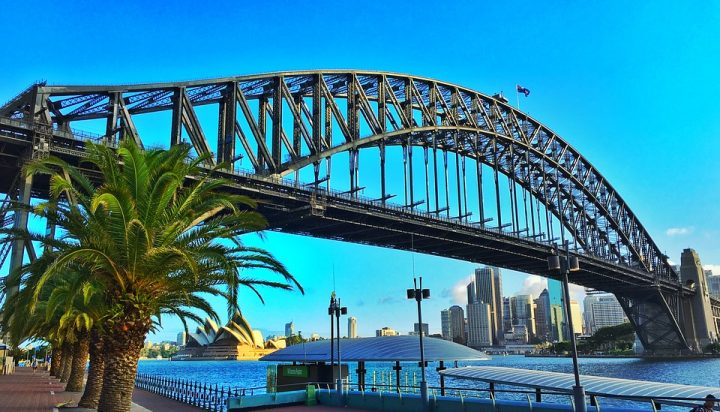
Sydney Harbour Bridge
The Sydney Harbour Bridge links Sydney’s two major commercial centres and forms a daily orientation point for millions. It is a living landmark, a tourist experience and an essential transport line for Sydneysiders. It is a cultural landscape that people actively experience: driving, walking, sailing, flying, cycling, ferry and train commuting, as well as passively observe – from the foreshores, from a distance, as a distinctive landmark – or examine in detail as a marvel of engineering technology.
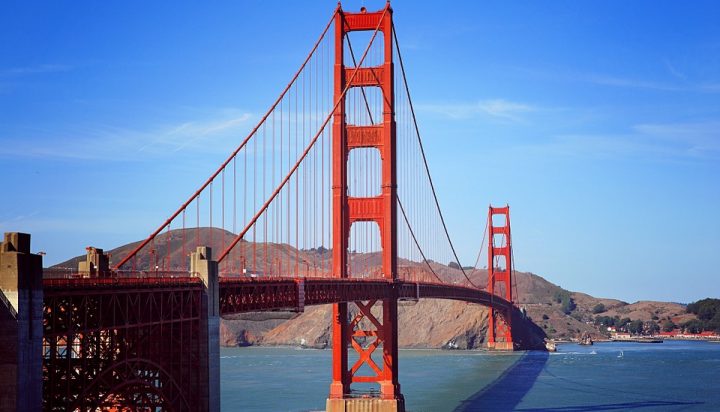
Golden Gate
The Golden Gate bridge is still considered one of the world’s engineering masterpieces. Today it carries over 100,000 vehicles per day (northbound and southbound). The Golden Gate has endured as a marvel of modern engineering; its 4,200-foot main span was the longest for a suspension bridge until 1981, while its 746-foot towers made it the tallest bridge of any type until 1993. It withstood the destructive Loma Pieta earthquake of 1989, and was closed to traffic only three times in its first 75 years due to weather conditions. Believed to be the most photographed bridge in the world, this landmark was named one of the seven civil engineering wonders of the United States by the American Society of Civil Engineers in 1994.
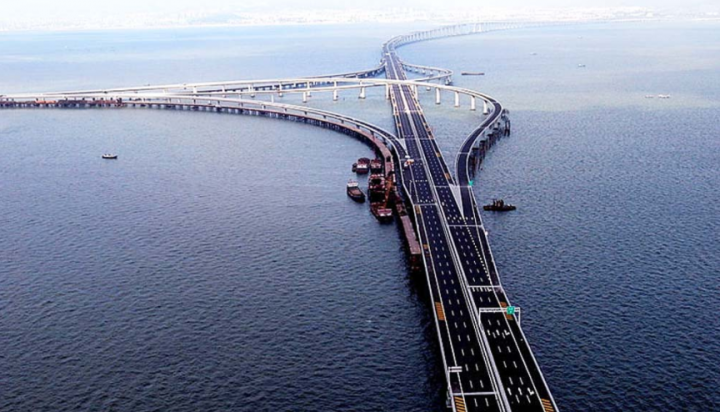
Qingdao Haiwan Bridge
In 2011, the Qingdao Haiwan Bridge became the world’s longest sea bridge. At 42.6 km long, it is nearly 5 kilometers longer than the previous record-holder, the Lake Pontchartrain Causeway, in Louisiana, USA. Costing $8.6 billion, the bridge links Qingdao city in China’s eastern Shandong province with the Huangdao district. The former is considered as the national tourism city of China and Huangdao is a suburban region which is moving towards becoming the next booming economic region. And the bridge is, therefore, is a great asset for tourism and trade.
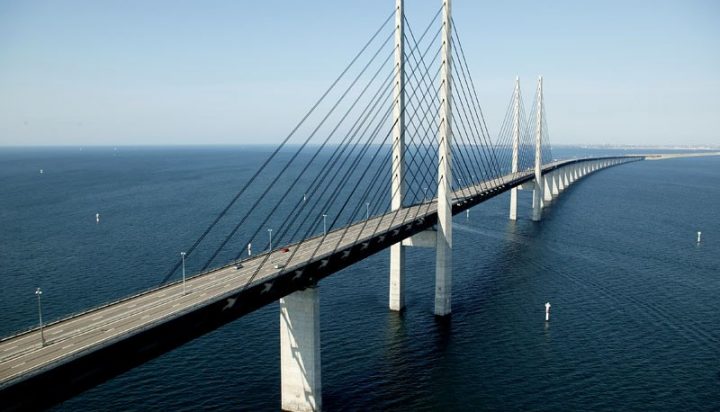
Øresund Bridge
The Øresund Bridge is an approximately 16-kilometer long road and rail link between Sweden and Denmark. It connects Copenhagen to Malmö fostering economic growth and cooperation for both cities. The link consists of three sections, a bridge, an artificial island and a tunnel, and the bridge accounts for half the length, with a railway and motorway running on separate levels. The bridge has provided a foundation for stronger and more extensive cooperation regarding economy, education, research and culture between Sweden and Denmark.
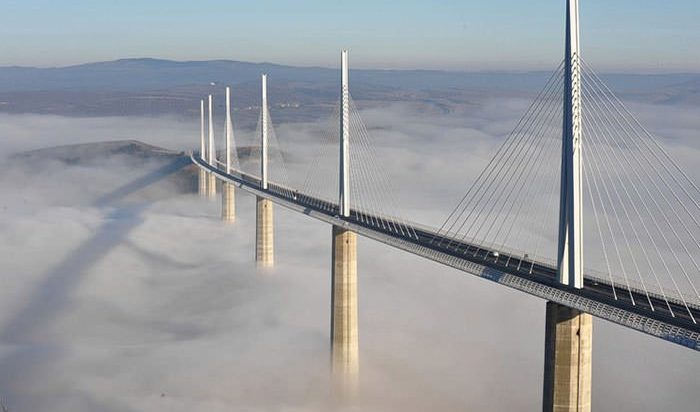
Millau Viaduct
Millau Viaduct is ranked as one of the great engineering achievements of all time. It opened in 2004 and was built across the Tarn valley to alleviate holiday traffic between France and Spain. This bridge broke several records. It has the highest pylons in the world (245 meters and 221 meters), the highest bridge tower in the world (343 meters) and the highest road bridge deck in Europe (270 meters). Millau Viaduct is so high that it glides above the clouds. In 2006, Millau Viaduct received the Outstanding Structure Award by the International Association for Bridge and Structural Engineering.
How to build higher?
In this video we will learn about vortex shedding and mass dampers.
Vortex shedding happens when wind hits a structure, causing alternating vorticies to form at a certain frequency. This in turn causes the system to excite and produce a vibrational load. Historically, it has been very difficult to calculate by hand. Today, with modern technology and new engineering practices, completing a vortex shedding analysis is a valuable tool used in the design of tall equipment and structures.
What is Mass Damper?
Mass Damper is the system that’s used to control movement in skyscrapers by reducing both the speed at which the building oscillates and the distance those oscillations cover. Mass dampers consist of large pendulums—usually steel plates bolted together to form a solid chunk—suspended from cables near the top of the building. When the building sways in a gust, the weight’s inertia acts as a counterweight, pulling it in the opposite direction.


